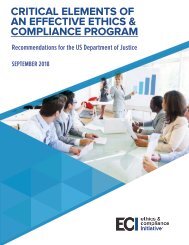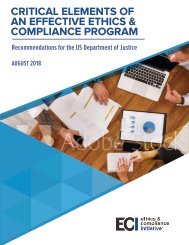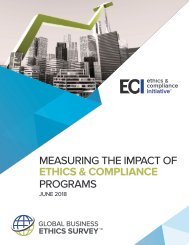ECI Maturity Model - DRAFT
You also want an ePaper? Increase the reach of your titles
YUMPU automatically turns print PDFs into web optimized ePapers that Google loves.
PRINCIPLE 4<br />
WHAT TO MEASURE/<br />
REVIEW<br />
• Organizational commitment to<br />
reporting/resolution/non-retaliation<br />
of employee concerns/suspected<br />
wrongdoing;<br />
• Employee perception that their<br />
concerns are solicited and heard;<br />
• Employee awareness of available<br />
avenues to report concerns;<br />
• Employee use of reporting channels;<br />
Leadership response to reported<br />
misconduct; and<br />
• Use of case management information/<br />
periodic assessments to measure<br />
effectiveness of reporting/resolution/<br />
non-retaliation.<br />
QUESTIONS TO CONSIDER<br />
• Does ethics and compliance training and<br />
communications effectively support a “Speak<br />
Up” culture?<br />
• Does leadership promote a “Speak Up”<br />
culture?<br />
• Does the organization provide a broad and<br />
varied number of reporting avenues?<br />
• Is the organization’s policy clear about its<br />
standards for tracking and resolution and<br />
sharing of employee concerns after cases are<br />
closed?<br />
• Are there controls with respect to fair<br />
treatment of reporters throughout the<br />
process?<br />
• Is action being taken against retaliators when<br />
evidence of retaliation is discovered?<br />
• Is feedback provided to employees making<br />
non-anonymous reports of misconduct?<br />
DOES THE ORGANIZATION ENGAGE IN HQP LEADING PRACTICES?<br />
• Questions from employees are solicited and listened to; raising difficult<br />
issues is expected and recognized as excellent performance.<br />
• Employees are made aware of available resources to support their<br />
speaking up. Awareness training addresses making ethical decisions in<br />
alignment with shared organizational values; seeking guidance; and the<br />
process that takes place when a report is made.<br />
• Employees are aware of the organization’s policy on “no retaliation.”<br />
• Leaders are skilled at responding well to issues raised by employees,<br />
and their employee feedback measures and case resolutions<br />
demonstrate this. Leaders are required to complete training and have<br />
easy access to guidance on responding to issues raised by employees<br />
and creating a speak-up culture.<br />
• Leaders’ performance in creating a speak-up culture is measured and<br />
managed.<br />
• Leaders speak regularly about – and formally recognize the value of –<br />
raising issues<br />
• Courage in raising concerns is broadly and publicly recognized and<br />
individually rewarded in employee performance reviews.<br />
• All communication materials concerning reporting channels are vetted<br />
to ensure that there is no implication that reporters cannot (or should<br />
not) also report to government.<br />
• The organization’s confidentiality agreements with employees and<br />
partners make clear that organizational policy does not hinder or<br />
discourage reporters’ rights to report to the government.<br />
• The organization seeks to dispel whistleblower stereotypes and expects<br />
leaders to responsibly handle reports from employees.<br />
• If an employee opts to make a report to government authorities, he/she<br />
is protected from all forms of retaliation.<br />
• The organization provides means for employees to anonymously, where<br />
permitted by law, and safely report via the phone and the internet, at<br />
minimum. When appropriate, these channels include global coverage,<br />
including accommodation of those who require translation services.<br />
• The organization’s policy is clear about its standards for escalating and<br />
tracking significant issues.<br />
04<br />
POTENTIAL SOURCES OF<br />
INFORMATION<br />
• Organization policies on reporting,<br />
THE ORGANIZATION ENCOURAGES,<br />
PROTECTS AND VALUESTHE REPORTING OF<br />
CONCERNS AND SUSPECTED WRONGDOING<br />
tracking and resolution of employee<br />
concerns;<br />
• ethics and compliance training and<br />
communication materials specifically<br />
related to “Speaking Up” requirements;<br />
• Ethics and compliance hotline/case<br />
management data/information related<br />
to reporting of employee concerns,<br />
investigations, and related follow-up;<br />
• Results of regular Speak Up Program<br />
Assessments and/or employee surveys;<br />
and<br />
• Communications and activities<br />
supporting and promoting a Speak Up<br />
culture.<br />
• The focus is on investigation of allegations, not the reporter.<br />
• Discipline is never imposed against an employee for taking action to<br />
report an issue.<br />
• Disciplinary processes are regularly reviewed to ensure the following:<br />
– Actions taken do not involve any retaliation or the appearance of it<br />
(e.g., taking into account the past reporting history of the employee<br />
reporter).<br />
– Mitigation of any risk that disciplinary actions taken might<br />
discourage future reporting.<br />
• All leaders are trained to be aware of the organization’s policy on<br />
retaliation and the behaviors that may be perceived as retaliation.<br />
• Over an extended period of time, the organization periodically<br />
touches base with reporters to ensure that they have not experienced<br />
retaliation.<br />
• In addition to the feedback from individual employees, the<br />
organization recognizes that employees may not feel comfortable<br />
reporting retaliation; therefore, it continues to monitor the long-term<br />
success of employees who report suspected violations.<br />
• Investigations of retaliatory behaviors receive special handling and<br />
priority to ensure responsiveness and neutrality.<br />
• Substantiated retaliation cases are reviewed by senior management<br />
and are reported to the organization and the board.<br />
• The organization makes every effort to personally thank reporters for<br />
their courage in coming forward.<br />
• Where possible, employee reporters are directly informed of the<br />
outcome of investigations based on their reports.<br />
• Outcomes of reported misconduct and the consequences that<br />
resulted in substantiated cases are regularly shared with all<br />
employees.<br />
• The organization prepares an annual public reporting of E&C activities,<br />
including reporting trends and responses to issues.








